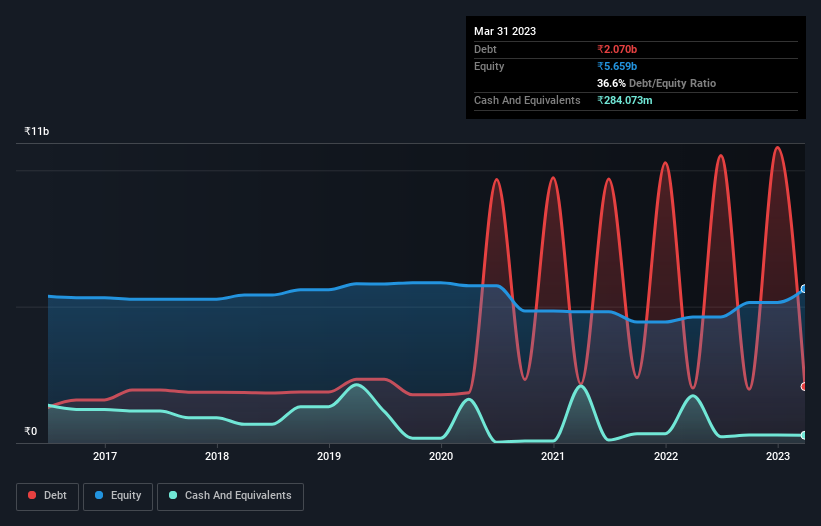- India
- /
- Hospitality
- /
- NSEI:WESTLIFE
Here's Why Westlife Foodworld (NSE:WESTLIFE) Can Manage Its Debt Responsibly

David Iben put it well when he said, 'Volatility is not a risk we care about. What we care about is avoiding the permanent loss of capital.' So it might be obvious that you need to consider debt, when you think about how risky any given stock is, because too much debt can sink a company. We can see that Westlife Foodworld Limited (NSE:WESTLIFE) does use debt in its business. But should shareholders be worried about its use of debt?
What Risk Does Debt Bring?
Debt assists a business until the business has trouble paying it off, either with new capital or with free cash flow. If things get really bad, the lenders can take control of the business. However, a more usual (but still expensive) situation is where a company must dilute shareholders at a cheap share price simply to get debt under control. By replacing dilution, though, debt can be an extremely good tool for businesses that need capital to invest in growth at high rates of return. When we think about a company's use of debt, we first look at cash and debt together.
View our latest analysis for Westlife Foodworld
What Is Westlife Foodworld's Debt?
The chart below, which you can click on for greater detail, shows that Westlife Foodworld had ₹2.07b in debt in March 2023; about the same as the year before. However, it also had ₹284.1m in cash, and so its net debt is ₹1.79b.

How Healthy Is Westlife Foodworld's Balance Sheet?
Zooming in on the latest balance sheet data, we can see that Westlife Foodworld had liabilities of ₹3.95b due within 12 months and liabilities of ₹11.4b due beyond that. Offsetting these obligations, it had cash of ₹284.1m as well as receivables valued at ₹188.1m due within 12 months. So its liabilities outweigh the sum of its cash and (near-term) receivables by ₹14.9b.
Given Westlife Foodworld has a market capitalization of ₹115.4b, it's hard to believe these liabilities pose much threat. Having said that, it's clear that we should continue to monitor its balance sheet, lest it change for the worse.
We use two main ratios to inform us about debt levels relative to earnings. The first is net debt divided by earnings before interest, tax, depreciation, and amortization (EBITDA), while the second is how many times its earnings before interest and tax (EBIT) covers its interest expense (or its interest cover, for short). The advantage of this approach is that we take into account both the absolute quantum of debt (with net debt to EBITDA) and the actual interest expenses associated with that debt (with its interest cover ratio).
Westlife Foodworld has a very low debt to EBITDA ratio of 0.47 so it is strange to see weak interest coverage, with last year's EBIT being only 2.5 times the interest expense. So one way or the other, it's clear the debt levels are not trivial. Pleasingly, Westlife Foodworld is growing its EBIT faster than former Australian PM Bob Hawke downs a yard glass, boasting a 227% gain in the last twelve months. When analysing debt levels, the balance sheet is the obvious place to start. But ultimately the future profitability of the business will decide if Westlife Foodworld can strengthen its balance sheet over time. So if you want to see what the professionals think, you might find this free report on analyst profit forecasts to be interesting.
Finally, a company can only pay off debt with cold hard cash, not accounting profits. So it's worth checking how much of that EBIT is backed by free cash flow. During the last two years, Westlife Foodworld produced sturdy free cash flow equating to 50% of its EBIT, about what we'd expect. This free cash flow puts the company in a good position to pay down debt, when appropriate.
Our View
Westlife Foodworld's EBIT growth rate suggests it can handle its debt as easily as Cristiano Ronaldo could score a goal against an under 14's goalkeeper. But we must concede we find its interest cover has the opposite effect. When we consider the range of factors above, it looks like Westlife Foodworld is pretty sensible with its use of debt. That means they are taking on a bit more risk, in the hope of boosting shareholder returns. We'd be motivated to research the stock further if we found out that Westlife Foodworld insiders have bought shares recently. If you would too, then you're in luck, since today we're sharing our list of reported insider transactions for free.
When all is said and done, sometimes its easier to focus on companies that don't even need debt. Readers can access a list of growth stocks with zero net debt 100% free, right now.
Valuation is complex, but we're here to simplify it.
Discover if Westlife Foodworld might be undervalued or overvalued with our detailed analysis, featuring fair value estimates, potential risks, dividends, insider trades, and its financial condition.
Access Free AnalysisHave feedback on this article? Concerned about the content? Get in touch with us directly. Alternatively, email editorial-team (at) simplywallst.com.
This article by Simply Wall St is general in nature. We provide commentary based on historical data and analyst forecasts only using an unbiased methodology and our articles are not intended to be financial advice. It does not constitute a recommendation to buy or sell any stock, and does not take account of your objectives, or your financial situation. We aim to bring you long-term focused analysis driven by fundamental data. Note that our analysis may not factor in the latest price-sensitive company announcements or qualitative material. Simply Wall St has no position in any stocks mentioned.
About NSEI:WESTLIFE
Westlife Foodworld
Through its subsidiary, Hardcastle Restaurants Private Limited, owns and operates a chain of McDonald's restaurants in Western and Southern India.
High growth potential and slightly overvalued.
Similar Companies
Market Insights
Community Narratives




